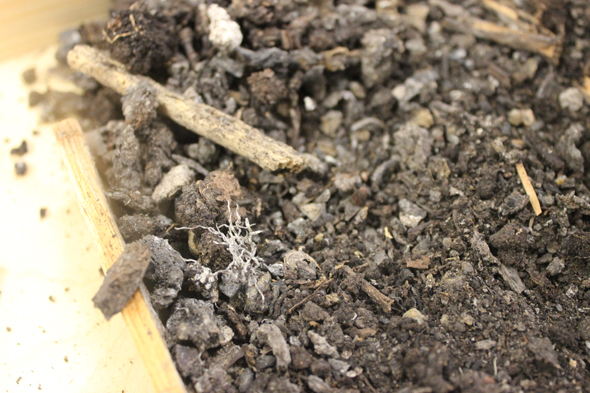
Textile fragment during excavation. Photo: Nathalie Hinders, SHMM
We already know that the Dags mosse mire was not only used during the Middle Neolithic. The material traces of these post Stone Age activities are by no means comprehensive but they do exist. The radiocarbon analysis of human bones revealed one individual from the Early Roman Iron Age (Browall 2011, p. 391; Browall 2016, p. 61). Herring scales from a herring larger than the average Baltic herring were found in the excavations of 1911. The scales come from a North Sea or North Atlantic herring, suggesting that they are instrusive (Browall 2011, p. 337). During the registration of the assemblages within the framework of the present infrastructure project we have found small amounts of glazed pottery and glass from the Eastern Trench. These are medieval or post-medieval. They were discovered high up in the stratigraphy.
When we discovered the three textile fragments under the Stone Age pottery in our excavation of the peat block (see blog post of 11 February 2016 ) we thought the context was relatively secure. If any intusive elements were discovered, we assumed that they would date from the time of excavation. However, we were proved wrong. The results from the Brussels lab have come and they show that one of the textile fragments is from the Middle Ages. 1430 – 1455 calibrated AD with 68,2% probability or 1415- 1475 calibrated AD with 95,4% probability (RICH 23700). We have two fragments left that can be further studied. The textile specialist at the Swedish History Museum, Helen Persson, has looked at the dated fragment and says it looks like a textile made of tree bast, for example lind or hemp, and that the fibres are spliced rather than draft spun. It appears still to be an unusual find, as coarser fragments are more common and this discovery is much finer. In a future blog post Helen will return to this question.
It remains difficult to understand how these medieval textiles can have been deposited under the several thousand years older potsherds. The peat block in which they were contained was removed from the mire in 1930 from the excavation square C9. Even though the wooden platform that is the Alvastra pile dwelling was relatively intact when it was excavated, there are other features which must have entailed disturbances in the original stratigraphy of the site. The site was cultivated for a long time and was also used as pasture. Several drainage ditches, 2 m deep, have been cut into the site at various places and there are two hollows ( Eastern and western hollow) which are also referred to as disturbances. None of these features are near the square C9 as far as I can see. In 1908, just before the site was discovered five drainage ditches, 2 m deep, were dug in preparation for the erection of a building. Drainage and cultivation can have affected the stratigraphy of some parts of the site whereas it in other parts seems to be intact.
I cannot deny that the medieval date was a disappointment at first but it was after all not in vain. It can contribute information to medieval textile research.
References:
Browall, H., 2011. Alvastra pålbyggnad. 1909-1930 års utgrävningar. Kungl. Vitterhets Historie och Antikvitets Akademien. Handlingar, Antikvariska serien 48. Stockholhm.
Browall, H., 2016. Alvastra pålbyggnad. 1976-1980 års utgrävningar. Västra schaktet. Kungl. Vitterhets Historie och Antikvitets Akademien. Handlingar, Antikvariska serien 52. Stockholm.
Bli först att kommentera